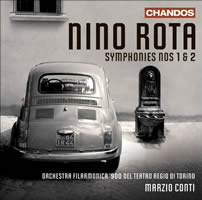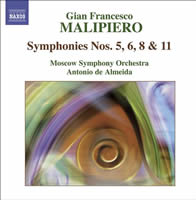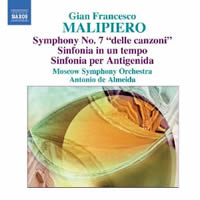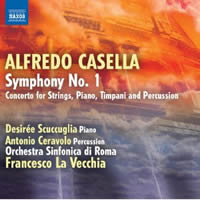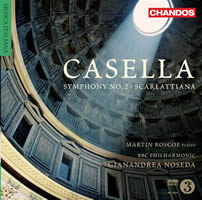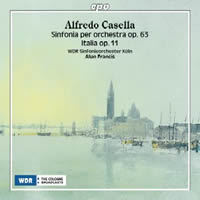Mostly Symphonies 13. / Italian Vacation 8.
|
Grant Chu Covell [August 2010.]
Nino ROTA: Symphony No. 1 (1935-39); Symphony No. 2, “Tarantina – Anni di pellegrinaggio” (1937-39). Filarmonica ’900 del Teatro Regio di Torino, Marzio Conti (cond.). Chandos CHAN 10546 (http://www.chandos.net/). Distributed in the US by Naxos (http://www.naxos.com/). Gian Francesco MALIPIERO: Symphony No. 5, “concertante in eco” (1947); Symphony No. 6, “degli archi” (1947); Symphony No. 8, “Symphonia brevis” (1964); Symphony No. 11, “delle cornamuse” (1969). Moscow Symphony Orchestra, Antonio de Almeida (cond.). Naxos 8.570880 (http://www.naxos.com/). Gian Francesco MALIPIERO: Symphony No. 7, “delle canzoni” (1948); Sinfonia in un tempo (1950); Sinfonia per Antigenida (1962). Moscow Symphony Orchestra, Antonio de Almeida (cond.). Naxos 8.570881 (http://www.naxos.com/). Well before Rota hit his stride as film scorer, he wrote two symphonies in the late 1930s, sparkling quasi-Romantic works in traditional four-movement design. Early on Rota decided dissonant modernity wasn’t for him — ironically, the First is dedicated to Petrassi, who enabled first performances. The Second wasn’t performed until 1975 (a year after The Godfather: Part II). Rota was a master craftsman, effortlessly floating memorable themes over attractive counterpoint. The perkiest moments, such as the Second’s scherzo / tarantella, could cover a Puccini café scene. Rota’s concert works such as the Harp Concerto (1947) or the much later Bassoon Concerto (1974-77) (both on Chandos CHAN 9954) sport Neoclassical guises, mixing Mozart with Les Six. The Second’s polish hints at Rota’s later flexibility, despite Mahlerian gravitas and winks towards Dvořák’s New World. If you tuned in after the announcement, you’d be compelled to stay with the broadcast simply to get the composer’s name. Contrasting Rota with Malipiero is perhaps a too-cruel stretch. The majority of Malipiero’s symphonies, coming as they do decades following Rota’s, exhibit little interest in perpetuating Romantic models. Rota delivers warmth, whereas Malipiero pouts and grimaces. These two discs complete the Naxos survey of Malipiero’s symphonies. The disc with the Fifth, Sixth, Eighth and Eleventh reveals scant moments one would call memorable. Its notes insist that Malipiero’s string-orchestra Sixth is his most frequently played symphony. While this may be true, it’s rather surprising. The Fifth contains extended concertante parts for two pianos. Despite its subtitle, the Eighth is not Malipiero’s shortest. On this release the Fifth and the “bagpipe” Eleventh finish sooner; the Sixth is a mere four seconds longer. Naxos’ fourth Malipiero installment offers the Seventh and two from a period between Nos. 7 and 8 when numbering was unimportant: The chronology of Malipiero’s 17 symphonies can’t be precisely determined by number. Antigenida is named for an ancient musician whose art went unremarked by his peers. The composer evidently had sympathy for this Theban flutist. The four-movement work is surprisingly dissonant and terse, as well as one of Malipiero’s more interesting caustic utterances.
Alfredo CASELLA: Symphony No. 1, Op. 5 (1905-06); Concerto for Strings, Piano, Timpani and Percussion, Op. 69 (1943)*. Desirée Scuccuglia* (pno), Antonio Ceravolo* (perc), Orchestra Sinfonica di Roma, Francesco La Vecchi (cond.). Naxos 8.572413 (http://www.naxos.com/). Alfredo CASELLA: Symphony No. 2, Op. 12 (1908-10); A notte alta for piano and orchestra, Op. 30b (1917/21)*. Sun Hee You* (pno), Orchestra Sinfonica di Roma, Francesco La Vecchi (cond.). Naxos 8.572414 (http://www.naxos.com/). Alfredo CASELLA: Symphony No. 2, Op. 12 (1908-10); Scarlattiana, Op. 44 (1926)*. Martin Roscoe* (pno), BBC Philharmonic, Gianandrea Noseda (cond.). Chandos CHAN 10605 (http://www.chandos.net/). Distributed in the US by Naxos (http://www.naxos.com/). Alfredo CASELLA: Symphony No. 3, Op. 63 (1939-40); Italia, Op. 11 (1909). WDR Sinfonieorchester Köln, Alun Francis (cond.). cpo 777 265-2 (http://www.cpo.de/). Distributed in the US by Naxos (http://www.naxos.com/). Naxos’ notes dispense with Casella’s disagreeable aspects head on: The Italian symphonist was a Fascist and a sexist. Showing musical talent at a young age, he won a scholarship to attend the Paris Conservatoire, studied with Fauré and befriended Ravel and Enescu. He stayed in Paris until the First World War, flirting with a variety of styles often peppered with dissonance and atonality, gradually settling on the tonal side of the fence. Casella’s advocacy — some would say fanaticism — led to Mahler’s 1910 appearance in the French capital to conduct his Resurrection Symphony. Casella’s 1939 Vivaldi Week brought the red-haired priest back into vogue. From ’27 to ’29, Casella served as Arthur Fiedler’s Boston Pops predecessor. If you like John Williams’ film scores, you’d probably like Casella’s symphonies. It appears Chandos, cpo and Naxos are each assembling Casella series. Naxos plans four discs with cover art that departs from their familiar handbill design. Naxos and Chandos announce their Second as a premiere recording: Naxos’ tapes rolled in 1/2009, Chandos’ precisely one year later. To judge from their first two releases, Naxos’ pairings emphasize Casella’s contradictions: Puccini-lite vs. Bartókian angularity, Mahler vs. dark impressionism. The ink was still wet on the pages of Casella’s First at the composer’s 23rd birthday. Its precocious three movements indiscriminately cast a wide net, whereas the anchor sits somewhere between Germany and France, with a clear view of Russia. The melancholic cellos are reminiscent of Mahler, the brass fanfares could slip into Götterdamerung or Strauss’ Alpine climb, and the violin filigree could have served nicely in Tchaikovsky’s early symphonies. Owing perhaps to the vistas that follow pregnant introductions, at nearly three-quarters of an hour, it doesn’t feel overly long. The Concerto is a different beast. Scored for Paul Sacher’s ensemble, Casella’s exasperated Neoclassical style shares the bluntness of similarly scored works by Bartók, Bloch and Martin. Yet the Concerto’s cool masks a deeper involvement. Accepting Naxos’ arbitrary juxtaposition, Casella’s Concerto primitivism operates as a refreshing change from the Romantic First. Notwithstanding its many Mahlerian touches, the Second (dedicated to George Enescu) lacks the Austrian’s angst. Funeral marches, lachrymose gestures and belabored Weltschmertz run rampant in Casella’s Second. Whereas Mahler fears the evil that lurks in the forest, Casella dances a tarantella at the wood’s edge. Such levity actually pulls Casella towards Prokofiev’s ironic handling of tonality. Despite Casella’s best intentions, much of the Second, especially the closing march, sounds like Dukas’ Sorcerer’s Apprentice or Rimskian wizardry à la Scheherazade or Le Coq d’Or. Noseda’s pace (49:20) is brisker than La Vecchia’s (55:43). The scherzo definitely warrants speed. However, the Finale’s Epilogo is better slower. I am hard pressed to recommend one reading over the other. Those invigorated by startling pairings may prefer the Naxos release. Curiously both “B-sides” are works for piano and orchestra. The neo-Baroque Scarlattiana for piano and small orchestra swirls themes from D. Scarlatti’s keyboard sonatas. Given the Romantic swooning and Spanish touches, it’s hard to believe that the same hand could write this Poulenc / Stravinskian pastiche and the Mahlerish Second. The Minuetto processes themes from the E-major sonata (K. 380) which Lukas Foss would manipulate years later in his 1967 Baroque Variations. Similarly contrasting, the atmospheric A notte alta for piano and orchestra is a languid, rhapsodic and morose arrangement of a solo piano work “inspired by emotional events.” Casella is good at gloom and doom. Neither Scarlattiana nor A notte alta are concertos in the strictest sense. The piano will appear after a long silence to deliver unique material, only to withdraw. There are moments in both pieces when I forgot to anticipate a soloist. Later in life Casella turned his back on Nos. 1 and 2 as puerile embarrassments. Written for the Chicago Symphony Orchestra’s 50th anniversary (Stravinsky’s Symphony in C and Kodály’s Concerto for Orchestra were also requested for the same occasion), the ostensibly mature Third was published by Universal Edition simply as Sinfonia. In four movements adhering to traditional design, the Third reflects several mid-century options. The opening wind wavering suggests Nielsen, the slow movement’s guarded dissonance recalls Prokofiev, and the scherzo and finale’s martial tone conjure that old idol, Mahler. The weighty preambles are history; Casella gets down to business. Well-received in its day and predominantly tuneful, the Third lacks an individuality that might have kept it in play. Italia, a wide-ranging fresco, sends two postcard vistas — the first of a volcanic, sun-baked Sicily, the other of a bustling Naples. Folk tunes occur throughout, including Denza’s Funiculì Funiculà, startling in its familiar ebullience. Unlike the Third, Italia is clearly nationalistic.
[Previous Article:
Christian Marclay at the Whitney]
[Next Article:
Recordings Revisited 2.]
|
